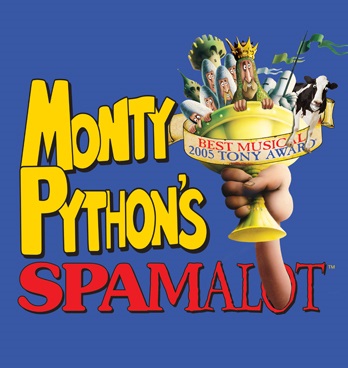Spamalot! @ The Egyptian Theatre 11.29
Art
I was eager to get to my seat so I strode through the people on Main Street in Park City, dodging around their five-wide groups and wriggling between fancy housewives and ornery gentlemen (worthy candidates for “upper-class twit of the year”) before I found my way the Egyptian Theatre. Shortly after arriving, they opened the doors, I grabbed a brew, and headed up to the balcony. I found the row my seat was supposed to be in, though the numbers on the seats went five, six, eight.
My seat was seven. Where is my goddamn seat? In the balcony area, there are two separate sections and mine must be in the other, I thought, so I walked over to find that my seat wasn’t where it was supposed to be on that side either. I felt like I had taken too many “getting hit in the head” lessons before I finally found my seat in the wrong row (my seat was in the A row, but the seat labeled A7 was in the B row), and sat down. The Egyptian Theatre, ‘tis a silly place.

The performance began with a historian setting the scene in Britain, which was evidently misheard by the cast, who instead performed a song about Finland. Jesus, nobody knows what’s going on.
The Egyptian Theatre doesn’t have a grasp of ordinal numbers, the play is set in Britain but the songs are about Finland, and some lady just fell over behind me (no joke, she tripped on the step). To add a dash of confusion to the whole ordeal, an usher caught my attention to tell me that I was in the wrong seat.
“But my ticket says A7 and this seat is labeled A7,” I said, partially expecting to get into a proper argument. “Oh yes, the chairs must be mixed up. Yours is in the front in the corner.” Utterly befuddled, I moved once more and the show went on.
The great thing about Spamalot! is that it knows from the very start that it’s a Broadway play. They take styles of songs that are common in musicals and call attention to them—nearly every genre is there, from a faux-Vegas style number (“Knights of the Round Table”) to a swelling motivational tune (“Find Your Grail”), all the way to one really odd number involving the Lady of the Lake’s Cheerleaders (a big what-the-fuck moment).
While a lot of the performance sticks to the main plot of the film Monty Python and the Holy Grail—the Knights Who Say Ni are present, as well as Not Dead Fred, who has his own number—it differs in a few ways. The fun was in finding these distinctions. For instance, in Spamalot! Sir Lancelot has a secret that’s revealed by a very erotic and glittery musical number towards the end (and actually, it was probably one of the most entertaining, though I wasn’t quite expecting dude smooches and man bulges). The performance also gives a voice to the famous “watery tart” who distributes swords. The Lady of the Lake (played by Jennifer Chadwick) has a few musical numbers in the performance and plays an integral role in the plot. Chadwick was a particularly impressive choice for the part. Her powerful pipes were spot-on even for high-pitched operatic notes, especially on “Find Your Grail” and “Whatever Happened to my Part?”
The performance really steers itself away from the film and into the utterly silly when the Knights Who Say Ni aren’t simply satisfied with a shrubbery. Once Arthur brings them the shrubbery, they become the Knights Who Say Ecky Ecky something-or-other, that somehow involves Daft Punk’s “Get Lucky” (they said they were “up all night for new shrubberies”), then decide that King Arthur must provide them with a Broadway musical before they allow him to pass through the forest. But, as Sir Robin explains in the whimsical tune “You Won’t Succeed on Broadway,” they can’t have a Broadway musical without any Jews (everyone knows that!). The quest for the Grail has now become a quest for Jews, which will help them with their Broadway play, thereby allowing them to pass through the dark forest inhabited by the Knights Who Say Ni so that they can then find the Grail. Are you still with me?
After a wide variety of interesting and hilarious numbers (and of course, a vicious rabbit), the Knights actually find that they’ve been in a musical all along (gasp!), that there was a Jew in their midst (mazel tov!), and that the Grail really wasn’t very far from them either. The knights find the Grail (something they’re hilariously unable to do in the film) and there’s a wedding—which is evidently a key component to any good musical. Huzzah!
If I’m looking on the bright side of life, it really couldn’t have been a much better performance or adaptation. I honestly didn’t expect to be surprised when I know the film so well, but the jokes were hilarious, there was plenty of extra content for those who have seen the movie a million times, and the musical numbers were well-rehearsed and performed spectacularly. I’ve still got some of the songs ringing in my head, but it’s nothing a few classic Python sketches can’t cure. If I had one small gripe, it’s that while these actors were great, they just can’t quite match the delivery and comic timing of the cast in the film, but who could expect them to? Monty Python and the Holy Grail is a one-of-a-kind film that can never be reproduced in any way, shape, or form. Well, I could see it working as musical—somebody should really get on that.
Check out what the Egyptian Theatre has coming up next here.



